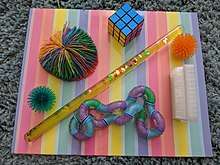Sensory room
[1] A sensory room is a special room designed to develop a person's sense, usually through special lighting, music, and objects.[2] It can be used as a therapy for children with limited communication skills.[3]
"Sensory Room" is an umbrella term used to categorize a broad variety of therapeutic spaces specifically designed and utilized to promote self-organization and positive change. There are multiple types of sensory rooms and purposes for use that have been created and implemented in different practice areas to date. When used appropriately, sensory rooms:
- Help to create a safe space
- Facilitate the therapeutic alliance
- Provide opportunities for engagement in prevention and crisis de-escalation strategies, as well as a host of other therapeutic exchanges (to teach skills, offer a variety of therapeutic activities, etc.)
- Promote self-care/self-nurturance, resilience & recovery [4]
History

The history of the sensory room dates back to the Netherlands' in the late 1970s and was invented by psychologists Ad Verheul and Jan Hulsegge. The original name for sensory rooms was, 'snoezelen' [5] and originated from a fusion of the two Dutch words, 'snuffelen' which means to sniff and 'doezelen' which means to doze or snooze. Over time this term has evolved to sensory room, multi-sensory room, and multi-sensory environments (MSE).[6] Originally, Verheul and Hulsegge worked together with individuals suffering from severe disabilities in an institution. The idea behind the sensory room was to provide an environment in which an individual can be exposed to various different forms of stimuli to awaken and release sensory perception.[7] The concept and usage of the sensory room has spread across Europe and the United States in the past fifty years to treat individuals with various different disabilities, disorders, and conditions.[8]
Equipment
Sensory rooms are often stocked full of many different types of equipment. This equipment is used to assist students in focusing on the present moment and to better process sensory information. Stocked equipment may be provided for balance and movement (trampolines, balance bars, swings), calming pressure (blankets, stuffed animals), or fidgeting behavior (fidget spinners, puzzles).

Multi-sensory equipment is a vital and effective part in the treatment of sensory disorders with children and adults alike.[9] Some examples include: projectors and effect wheels, bubble tubes, music equipment, fibre optics, vibrating devices, aroma diffusers and sound equipment. Many schools have "Sensory Kits" which are personalized items of sensory stimulating equipment that are meaningful to the owner. These kits are held in Sensory Rooms as bins, boxes, bags, etc. to be used for preventative purposes and for any crisi that may occur. These kits are also used to help children create self organization skills that can increase cognitive processes and future life skills.
.jpg)
Sensory equipment can help develop key life skills including vocalization, gross motor skills, color recognition and tracking. Examples include sensory rooms, sensory pools, sensory bathrooms, and sensory gardens.
They are also sometimes called "multi sensory room", "white room", or "quiet room".[10][11][12]
Benefits
The benefits of sensory rooms haven't been researched that much, however, there are significant ways that sensory rooms can help many. The main benefit of sensory rooms is that they are a humane and effective way for individuals to manage their stress levels.[13] They can also help to manage negative thoughts and emotions.[14] Sensory rooms can be beneficial for those that have a history of aggression, because they can be useful in de-escalating aggressive behavior.[15] Adults that have an intellectual disability can use multi-sensory environments to allow emotional exploration and the chance to seek different kinds of stimulation, which can possibly be therapeutic. Relaxation is an important aspect of sensory rooms, and the different variables of multi-sensory rooms can possibly help reduce different kinds of problem behavior in patients.[16] Hospice care patients can benefit from using sensory environments because they can enhance their end-of-life experience. These environments introduce a variety of new and familiar routines that include the five different senses.[17]
Dementia
Dementia is a problem that impacts many people as they grow old after all our memories are not going to be what they used to be in our youth. One of the interesting ways that sensory rooms are being utilized is with patients with Dementia. Sensory information is helpful in improving the quality of life for people who have dementia and potentially other memory problems. In a recent study [18] they tested out various forms of Multi-sensory therapies. They found that there were positive effects for those with issues with agitation. They were able to help reduce agitation but there was no deeper healing from having dementia patients spend time in a sensory room.[19] Not all studies were in support of using sensory rooms for those suffering from dementia. In a recent study [20] they found that the use of sensory rooms was not able to bridge the gap between academic information and implementation of new information. This impacted the view of nursing home staff and they became reluctant to let the residents use them. With varying outcomes, we cannot make a solid judgment on whether or not sensory rooms impact dementia in a positive way for all patients.
See also
References
- Wiglesworth, Sophie; Farnworth, Louise (2016). "An Exploration of the Use of a Sensory Room in a Forensic Mental Health Setting: Staff and Patient Perspectives". Occupational Therapy International. 23 (3): 255–264. doi:10.1002/oti.1428. PMID 27237722.
- "Archived copy". Archived from the original on 2012-01-30. Retrieved 2012-02-22.CS1 maint: archived copy as title (link)
- "Discipline of Speech Pathology".
- "Sensory Rooms in Mental Health".
- "History of Multi-Sensory". specialhaven. Retrieved 2019-11-13.
- "Multi-sensory environments and their use by people with autism". Altogether Autism. 2017-03-17. Retrieved 2019-11-13.
- "History | Snoezelen Multi-Sensory Environments". Retrieved 2019-11-13.
- "Multi Sensory Environments: A Short History". www.cdhaf.org. Retrieved 2019-11-13.
- "Multi-sensory environments and their use by people with autism". 2017-03-17.
- "Discipline of Speech Pathology" (PDF).
- Champagne, Tina. "The Effects of the Sensory Room" (PDF). ot-innovations.com. Retrieved 17 November 2019.
- Smith, Suzanne; Jones, Julia (2013-12-04). "Use of a Sensory Room on an Intensive Care Unit" (PDF). Journal of Psychosocial Nursing and Mental Health Services. 52 (5): 22–30. doi:10.3928/02793695-20131126-06. ISSN 0279-3695. PMID 24305908.
- Novak, Theresa; Scanlan, Justin; McCaul, Damien; MacDonald, Nathan; Clarke, Timothy (2012-09-26). "Pilot study of a sensory room in an acute inpatient psychiatric unit". Australasian Psychiatry. 20 (5): 401–406. doi:10.1177/1039856212459585. ISSN 1039-8562. PMID 23014117.
- Adams-Leask, Karen; Varona, Lisa; Dua, Charu; Baldock, Michael; Gerace, Adam; Muir-Cochrane, Eimear (2018-02-08). "The benefits of sensory modulation on levels of distress for consumers in a mental health emergency setting". Australasian Psychiatry. 26 (5): 514–519. doi:10.1177/1039856217751988. hdl:2328/38712. ISSN 1039-8562. PMID 29417830.
- West, Monique; Melvin, Glenn; McNamara, Francis; Gordon, Michael (2017-01-31). "An evaluation of the use and efficacy of a sensory room within an adolescent psychiatric inpatient unit". Australian Occupational Therapy Journal. 64 (3): 253–263. doi:10.1111/1440-1630.12358. ISSN 0045-0766. PMID 28138979.
- Fava, Leonardo; Strauss, Kristin (January 2010). "Multi-sensory rooms: Comparing effects of the Snoezelen and the Stimulus Preference environment on the behavior of adults with profound mental retardation". Research in Developmental Disabilities. 31 (1): 160–171. doi:10.1016/j.ridd.2009.08.006. ISSN 0891-4222. PMID 19815373.
- Oksana K. Niedzielski; Gary Rodin; Debbie Emmerson; Job Rutgers; Katherine M. Sellen (2016-01-25). "Exploring Sensory Experiences and Personalization in an Inpatient Residential Hospice Setting - Oksana K. Niedzielski, Gary Rodin, Debbie Emmerson, Job Rutgers, Katherine M. Sellen, 2016". American Journal of Hospice and Palliative Medicine. 33 (7): 684–90. doi:10.1177/1049909115624398. PMID 26809827.
- Gonzalez, Marianne T.; Kirkevold, Marit (2014). "Benefits of sensory garden and horticultural activities in dementia care: a modified scoping review". Journal of Clinical Nursing. 23 (19–20): 2698–2715. doi:10.1111/jocn.12388. PMID 24128125.
- Douglas, Simon; James, Ian; Ballard, Clive (2004). "Non-pharmacological interventions in dementia" (PDF). Advances in Psychiatric Treatment. 10 (3): 171–177. doi:10.1192/apt.10.3.171. Retrieved 16 November 2019.
- Jakob, Anke; Collier, Lesley (2017). "Sensory enrichment for people living with dementia: Increasing the benefits of multisensory environments in dementia care through design". Design for Health. 1: 115–133. doi:10.1080/24735132.2017.1296274.